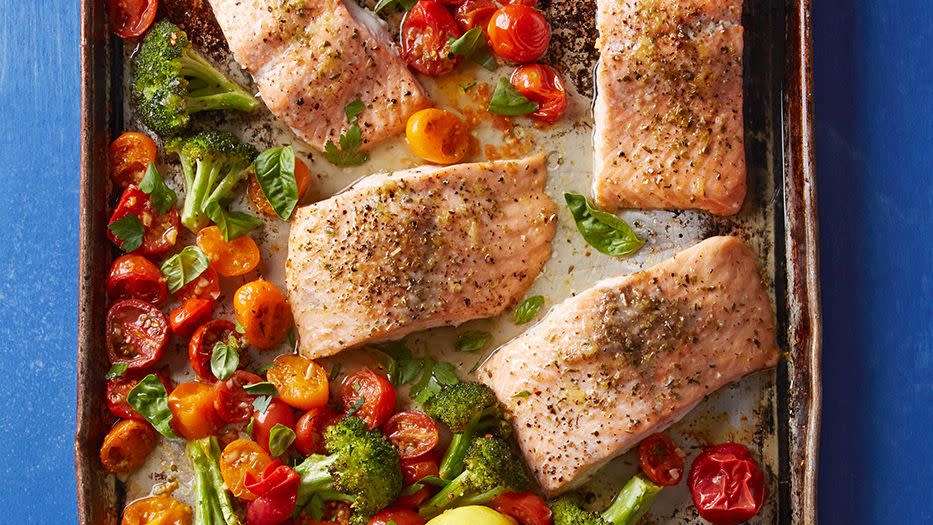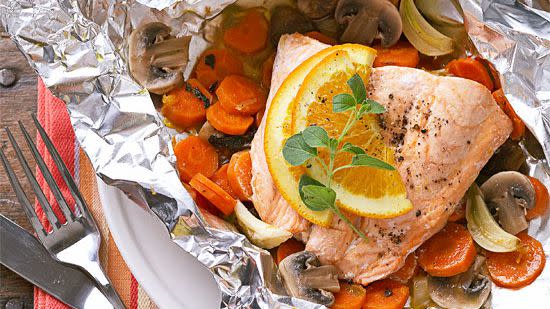How to Bake Salmon for Delicious and Healthy Meals in a Snap

A great source of protein and high in omega-3 fatty acids, baked salmon is a great choice for healthy weeknight meals and fancy dinners alike. Knowing how to cook salmon in the oven the right way is essential to mastering basic cooking techniques starring this popular seafood choice. Like most fish and seafood, salmon cooks quickly (even faster if you cut it into smaller pieces before popping in the oven) so a nutritious main dish is only minutes away. Because no one wants to eat overcooked fish, follow our best tips for making salmon in the oven.

Blaine Moats
How to Cook Salmon in the Oven
Use these methods before starting any baked salmon recipe even if you're baking fish without a recipe.
Step 1: Prep Salmon
Fresh or frozen, here are some prep tips to follow in order to make a perfect oven-roasted salmon.
Thawing: If salmon is frozen, allow enough time for it to thaw, covered, in the refrigerator. For faster thawing, transfer salmon to a resealable plastic bag and submerge in cold water. Change the water every 30 minutes to keep it cold. Continue the process until thawed.
Salmon Skin: For fillets with skin, if desired, use a sharp fillet knife to remove the skin from the raw salmon. You can also remove the skin after baking when it much more easily slips off. If any scales are on the skin, scrape them away before baking fish.
Pin Bones: Even if pin bones were removed at the market, there could be a couple of these tiny bones left behind. If you find any, remove them using clean needle-nose pliers ($14, The Home Depot) dedicated for kitchen use only. Pull out bones at a 45° angle toward where the head would be. You'll enjoy your baked fish much more if you avoid bites with unexpected bones.
Pat Fish Dry: It used to be recommended to rinse fish before baking, but fear of splattering uncooked fish changed that. We recommend not rinsing unless you need to rinse off any scales. Pat dry with paper towels whether you rinse or not.
Cut Smaller: Cut larger pieces of salmon into serving-size pieces for faster, more even baking, if desired.
Step 2: Bake Salmon in Oven
Preheat the oven to 450°F for salmon fillets and steaks or 350°F for pan-dressed fish (ready-to-cook whole fish with organs, fins, scales, gills, head, and tail removed). Place in a single layer on a greased, foil-lined 15x10-inch baking pan. For fillets, tuck under any thin edges to ensure even baking. Brush the fish with olive oil or melted butter and season as desired.
How Long to Bake Salmon
Oven-roasted salmon doesn't have a set temperature for doneness, so how long to bake salmon depends on the thickness of your fish. Measure the thickness of your salmon once you have it on your pan. Bake salmon, uncovered, 4 to 6 minutes per ½-inch thickness. Bake a dressed salmon 6 to 9 minutes per 8 ounces of fish. Always check your fish at the minimum baking time to ensure your baked salmon doesn't get overcooked.
Test Kitchen Tip: Seasoning salmon can be as simple as using salt and ground black pepper, especially if you are planning to serve it with a sauce. Common and simple seasonings are fresh or dried herbs, such as dill, thyme, or minced garlic. Sprinkling seasoning blends like garlic pepper, lemon pepper, or Italian seasoning is also a simple way to boost flavor.
How to Test Salmon for Doneness
To test for doneness, insert a fork and gently twist. The salmon is done as soon as it becomes opaque and begins to flake.
Related: Healthy Fish and Seafood Recipes You'll Want to Add to Your Menu ASAP

Oven-Baked Salmon in Foil
For baked salmon with veggies and some extra flavor, learn how to bake salmon in a foil packet (or parchment packet) with desired seasonings. Follow this baked salmon recipe in foil or parchment for any easy meal.
Preheat oven to 375°F. For each packet, cut an 18x24-inch piece of heavy foil and fold it in half to get an 18x12-inch piece.
Place desired vegetables, such as precooked carrots, sliced mushrooms, and sliced green onions, on the foil. Place one 4-ounce salmon fillet, cut ¾-inch thick, on top. Drizzle with 1 teaspoon olive oil, melted butter, or a splash of dry white wine. Sprinkle with salt and ground black pepper and, if desired, snipped fresh oregano, dill, finely shredded orange peel, and/or minced garlic. Top with halved orange slices.
Bring together two opposite foil edges and seal with a double fold. Fold remaining edges together to completely enclose salmon, allowing space for steam to build. Place the foil packets in a single layer in a shallow baking pan.
Bake 15 to 20 minutes or until fish begins to flake when tested with a fork and vegetables are tender (open packets carefully, as hot steam will escape). Use your recipe for more specific directions on how long to bake salmon in foil or parchment.
How to Select Salmon
When learning how to bake salmon, it's important to select the right fish. Fresh salmon is often available farmed or wild, with wild carrying the higher price tag. The country-of-origin label should tell you where the fish is from and if it is farmed or wild. Common forms of salmon include fillets, steaks, and whole fish. When cooking fresh salmon or making baked salmon fillets, ask your fish market to skin them for you, if desired.
Wild: Most varieties of wild salmon are available fresh May through October and frozen throughout the year. Wild salmon are typically Pacific coast varieties, such as coho (silver), sockeye (red), Chinook (king), pink, and chum.
Farmed: Atlantic salmon is generally farmed. Farmed salmon is often more readily available and sold at a lower price.
More Ways to Cook Salmon
Once you've mastered how to bake salmon, mix things up and cook it in other ways! Cook on the grill for a more smoky taste, or on a plank for a woody, smoked flavor. You can also keep it simple and cook salmon in a skillet for a quick and easy dinner.

